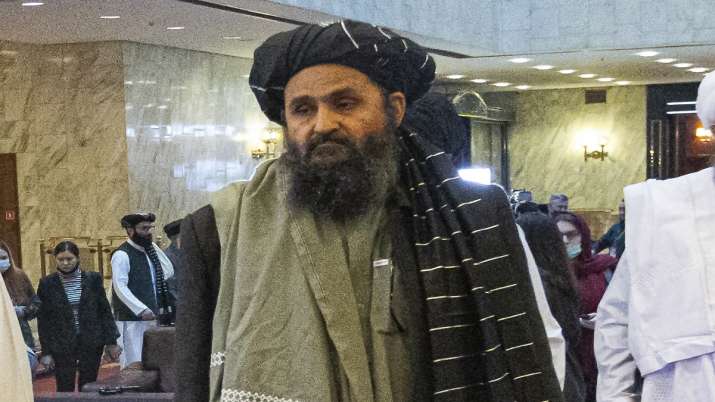
Mullah Abdul Ghani Baradar is now expected to play a key role in the talks between the Taliban and Afghan government officials, who were ousted by the terrorist group in its attacks across the country.
The Taliban’s top political leader, who made a triumphant return to Afghanistan this week, has battled the US and its allies for decades, but then signed a historic peace deal with the Trump administration.
Mullah Abdul Ghani Baradar is now expected to play a key role in the talks between the Taliban and Afghan government officials, who were ousted by the terrorist group in its attacks across the country. The Taliban say they want an “inclusive, Islamist” government and claim they have become more liberal since the last time they came to power.
But many are skeptical, and all eyes are now on Baradar, who has said little about how the group will govern but has proven pragmatic in the past.
Baradar’s biography traces the arc of the Taliban’s journey from an Islamic militia that fought warlords during a civil war in the 1990s, ruled the country according to a strict interpretation of Islamic law, and then waged a two-decade insurgency against the US . His experience also sheds light on the complex relations the Taliban have with neighboring Pakistan.
Baradar is the only surviving Taliban leader who was personally appointed deputy by the late Taliban commander Mullah Mohammad Omar, giving Baradar an almost mythical status within the movement. And he is far more visible than the current supreme leader of the Taliban, Maulavi Hibatullah Akhunzada, who is believed to be hiding in Pakistan and issues only occasional statements.
On Tuesday, Baradar landed in the southern Afghan city of Kandahar, the birthplace of the Taliban movement he founded in the mid-1990s. After ending his 20-year exile, he was received by well-wishers when he got off a Qatari government plane and drove into a convoy.
Baradar, who is in his early 50s, was born in southern Uruzgan province. Like others who would eventually become a Taliban leader, he joined the ranks of the CIA- and Pakistan-backed mujahideen to fight against the Soviet Union during the country’s decade-long occupation that ended in 1989.
In the 1990s, as the Mujahideen’s rival Mujahideen were fighting each other and building fiefdoms, the country was engulfed in civil war. The chieftains set up brutal security rackets and outposts, in which their army shook the travelers to provide funds for their military activities.
In 1994, Mullah Omar, Baradar and others founded the Taliban, which means religious students. The group consisted mainly of clerics and young, pious men, many of whom had been driven out of their homes and only knew of the war. His ruthless interpretation of Islam united his ranks and separated him from the notoriously corrupt warlords.
Baradar fought alongside Mullah Omar as he led the Taliban through his capture of power in 1996 and a return to insurgency following the US-led invasion of 2001.
During the group’s 1996–2001 rule, the chairman and governing council were based in Kabul. But Baradar spent most of his time in Kandahar, the spiritual capital of the Taliban, and did not have an official government role.
The US invaded Afghanistan after the 9/11 attacks, which was planned by Osama bin Laden’s al-Qaeda and was taking refuge under Taliban rule at the time. Baradar, Omar and other Taliban leaders fled to neighboring Pakistan.
In the ensuing years, the Taliban was able to organize a powerful insurgency based in the rugged and semi-autonomous tribal areas along the border. Baradar was arrested in 2010 in a joint raid by the CIA and Pakistan’s counter-terrorism forces in Pakistan’s southern city of Karachi.
At the time, he was making a peace offer for Hamid Karzai, the then President of Afghanistan, but the US was intent on a military victory and it seemed that Pakistan wanted to ensure control over any political process. Baradar’s expulsion empowered more radical leaders within the Taliban who were less open to diplomacy.
Karzai later confirmed the offer to The Associated Press, saying he had twice asked the Americans and Pakistanis to free Baradar, but he was refused. Baradar himself had refused an offer of release in 2013, apparently because the US and Pakistan placed conditions on his cooperation.
Karzai, now in talks with the Taliban to form the next government, may once again find himself negotiating with Baradar.
By 2018, the Taliban had effectively controlled most of Afghanistan’s rural areas. Seeking a way out of America’s longest war, the Trump administration persuaded Pakistan to release Baradar that year and began peace talks with the Taliban.
Baradar led the Taliban’s negotiating team in Qatar through several rounds of talks, culminating in a February 2020 peace deal. He also met the then US Secretary of State Mike Pompeo.
Under the agreement, the Taliban agreed to halt attacks on international forces and prevent Afghanistan from again becoming a haven for terrorist groups in exchange for a full US withdrawal, which is now planned for the end of the month.
Last week, the Taliban entered the country’s cities, taking over nearly the entire country in a matter of days, and then rolled into the capital, Kabul, almost unopposed.
In his first remarks since the capture of Kabul on Sunday, Baradar acknowledged his surprise, saying that “it was never expected that we would have a victory in Afghanistan.”
Wearing a vest over a black turban and white robe, Baradar looked straight at the camera. “Now comes the test,” he said. “We must face the challenge of serving and protecting our nation, and give it a steady life as we move forward.”
Read also | Taliban blows up statue of Shia militia leader who fought against them in Afghanistan civil war
Read also | Taliban fired at protesters carrying Afghanistan flag in Jalalabad, two killed
.